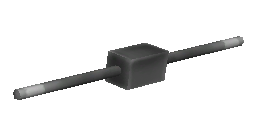Difference between revisions of "Communotron 16-S"
m (Blanked the page) |
AlpacaMall (talk | contribs) (Added usage) |
||
| (One intermediate revision by one other user not shown) | |||
| Line 1: | Line 1: | ||
| + | {{:Communotron 16-S/Box}} | ||
| + | The '''Communotron 16-S''' is an [[antenna]], used to connect to [[CommNet]] and transmit [[science]]. | ||
| + | |||
| + | It is the horizontal, static variant of the [[Communotron 16]]. It is one of the weakest direct antennae, weaker than the [[Communotron DTS-M1]]. | ||
| + | |||
| + | == Product description == | ||
| + | {{Quote | ||
| + | |A Surface mount version of the Communotron-16 | ||
| + | |manufacturer=ISPE}} | ||
| + | |||
| + | == Usage == | ||
| + | The Communotron 16-S shares the same antenna power as the [[Communotron 16]], and is identical in most [[CommNet]]-related aspects. | ||
| + | |||
| + | One difference between the 16 and the 16-S is that the Communotron 16-S is non-combinable. On a craft, combinable antennas can combine their antenna power, achieving a greater combined power. However, the 16-S cannot do this; attaching two to a craft results in the same antenna power as attaching one. For this reason, attaching more than one Communotron 16-S to a vessel is not recommended. | ||
| + | |||
| + | Because the 16-S is static, it is much more durable than the 16 when active; unlike a deployed Communotron 16, it cannot be destroyed by aerodynamic forces. This makes it a good choice for probes that must pass through an atmosphere (i.e. a [[Duna]] lander), as long as a [[CommNet#Connections through relays|relay network]] is set up beforehand. | ||
| + | |||
| + | The Communotron 16-S is one of the first two antennas unlocked in the tech tree (along with the 16). It is a [[physicsless part]], and its mass and drag are instead added to its parent part. | ||
| + | |||
| + | == Changes == | ||
| + | ;[[1.2]] | ||
| + | * Initial Release | ||
| + | |||
| + | {{Parts}} | ||
| + | [[Category:Antennae]] | ||
Latest revision as of 06:24, 22 August 2021
| Communotron 16-S | ||
| Antenna by Ionic Symphonic Protonic Electronics | ||
| Radial size | Radial mounted | |
| Cost | (total) | 300.00 |
| Mass | (total) | 0.015 t [1] |
| Drag | 0.2 [1] | |
| Max. Temp. | 2000 K | |
| Impact Tolerance | 7 m/s | |
| Research | | |
| Unlock cost | 750 | |
| Since version | 1.2 | |
| Part configuration | C16S.cfg | |
| Antenna type | Direct | |
| Antenna rating | 500 km | |
| Packet size | 2 Mits | |
| Transmission speed | 3.33 Mits/s | |
| Electricity required | 6 ⚡/Mits | |
| Packed volume | 5 l | |
| Stacking capacity | 4 units | |
| ||
The Communotron 16-S is an antenna, used to connect to CommNet and transmit science.
It is the horizontal, static variant of the Communotron 16. It is one of the weakest direct antennae, weaker than the Communotron DTS-M1.
Product description
| “ | A Surface mount version of the Communotron-16 — Ionic Symphonic Protonic Electronics |
” |
Usage
The Communotron 16-S shares the same antenna power as the Communotron 16, and is identical in most CommNet-related aspects.
One difference between the 16 and the 16-S is that the Communotron 16-S is non-combinable. On a craft, combinable antennas can combine their antenna power, achieving a greater combined power. However, the 16-S cannot do this; attaching two to a craft results in the same antenna power as attaching one. For this reason, attaching more than one Communotron 16-S to a vessel is not recommended.
Because the 16-S is static, it is much more durable than the 16 when active; unlike a deployed Communotron 16, it cannot be destroyed by aerodynamic forces. This makes it a good choice for probes that must pass through an atmosphere (i.e. a Duna lander), as long as a relay network is set up beforehand.
The Communotron 16-S is one of the first two antennas unlocked in the tech tree (along with the 16). It is a physicsless part, and its mass and drag are instead added to its parent part.
Changes
- Initial Release
